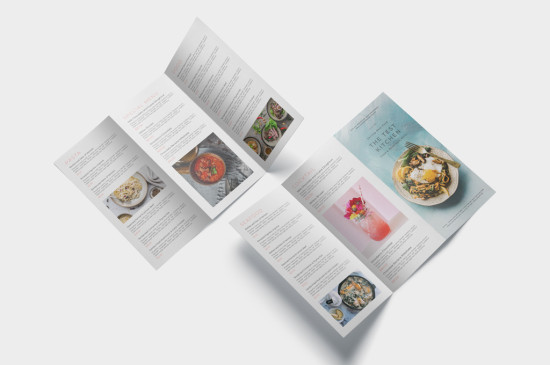 Folded Flyers
Folded Flyers
Folded flyers (or brochures) are a popular and cost-effective way to let others know about your business and to promote products, services, projects or events. Extra pages mean there’s more space for high quality photographs, diagrams and detailed descriptions.
Use the pages to tell the story of your company or product, target your audience and make valuable connections with customers and clients.
Whether you have a corporate style or would like a new or updated look, our graphic designers will keep your message and business brand front and centre. Their skills and experience ensures you’ll get a great result and value for money.
Options:
• Finished sizes: DL, A6, A5 or A4
• Quantities from 500
• Premium gloss stock in two weights
• Roll Fold or Z-Fold - please indicate which fold you would like in the Instructions & Comments field
• Delivery Australia-wide
Different names are often used for the folds. Here are some you might have seen:
• 4pp also called bi-fold or 2 fold flyer design and print
• 6pp known as tri-fold or 3 fold flyer design and print
• 8pp (pp = printed page)
Paper sizes
Standard International Paper Sizes come in three ranges – A, B and C. The most widely used for general printing and stationery is the A series.
A4 is known as international letterhead size (297mm x 210mm). It’s easy to hold, store in a file or folder, and has space for a lot of information, photographs and diagrams. Most office printers take A4 paper.
A3 is twice the size of A4, A5 is half that size and A6, or postcard size is half again. DL fits across an A4 sheet 3 times.
Printed pages
Printers and designers often speak of booklets and brochures having a certain number of printed pages or ‘pp’. For example, 2pp A5 means printing on both sides of an A5 sheet. A 6pp DL brochure means printing on both sides of an A4 sheet which is then roll folded or Z folded to make a DL. Each page is one side of the 6 DL sized panels of the brochure.
Portrait or landscape
Portrait or landscape orientation has its origin in visual art, referring to the ratio of dimensions used when painting a portrait of a person’s head and shoulders, or for a picture incorporating a built or natural landscape.
Portrait means the brochure design is on a vertical rectangle, landscape is horizontal. This is relevant when thinking about the size that a brochure is when it’s flat. For example, when it’s opened, a 4pp A4 landscape brochure is almost two feet across in the old measurements – 594mm x 210mm. Not only should the design take full advantage of the space, but the brochure needs to be on paper that is up to the task.
Paper types
Paper (or paper stock) used in commercial printing has a language all its own! The weight of paper is measured in gsm, or grams per square metre. As a guide, copy paper is 80gsm, gloss or matt brochure paper is commonly 150gsm and business cards are printed on 300gsm to 350gsm paper referred to as card stock or board.
You may have heard about coated and uncoated paper. That doesn’t refer to laminating or celloglazing, but how the paper is manufactured.
Uncoated stock is paper in its natural state. The miniscule gaps between the fibres mean it is more porous, will absorb more ink and has a slightly rough feel. When it is printed, edges are softer and colours not quite as bright, but it has a welcoming look and feel and is a great match for the right business brands. Terms such as laser bond or offset bond indicate uncoated paper. Most (but not all) 100% recycled stock is uncoated.
Coated stock is produced by filling the gaps between the paper fibres with chalk or china clay and natural or synthetic binders. The paper is then calendered – pressed between rollers – to smooth the surface. Coated stock is therefore less absorbent to ink, making printed colours brighter and detail crisper. When a paper is described as gloss, matt, satin or silk, this means it is coated.
The same weight uncoated paper often seems heavier than a coated stock, so it is a good idea to look at samples, or ask your printer or designer’s advice on choosing the right stock for your purpose.
Both coated and uncoated stock can be given further finishes such as celloglazing, laminating or spot UV varnish. It is often easier to write on uncoated stock if you’re getting appointment cards or forms printed. Coated stock, however, can be more resistant to moisture and dirt.
Wondering how to print a brochure in Word or PDF?
If you’re supplying your own artwork in Microsoft Word or PDF, it’s important to read our setup guide to make sure your documents will print the way you want.
Order online or talk to us at 1800-2-PRINT and we’ll get your project underway.
Need some more information?
- If you're not too sure about print finishes, you can check out our quick reference guide
- If you're setting up or supplying artwork to us, you can check out or our artwork setup guide
Still not sure, or need some more information? Get in touch with our team or call us.



